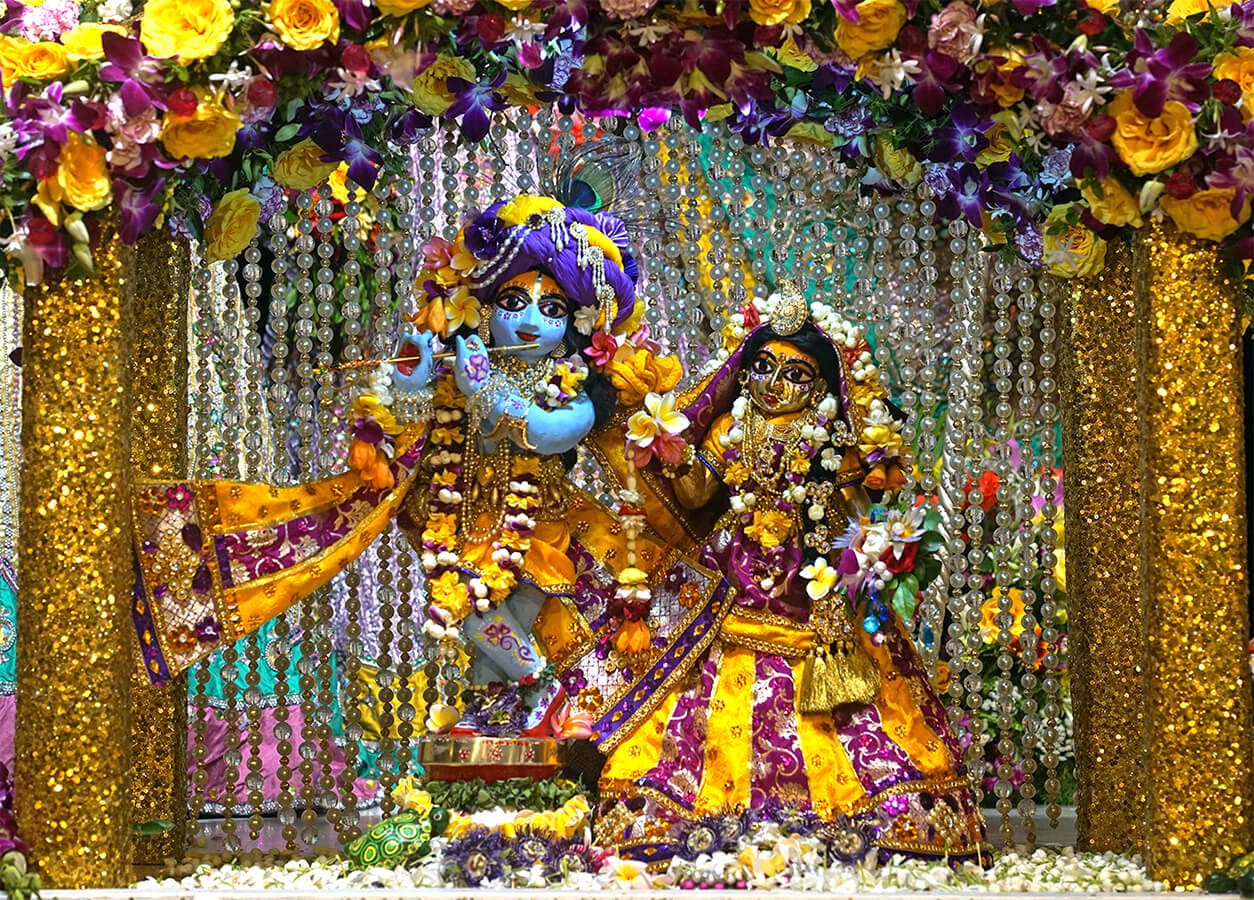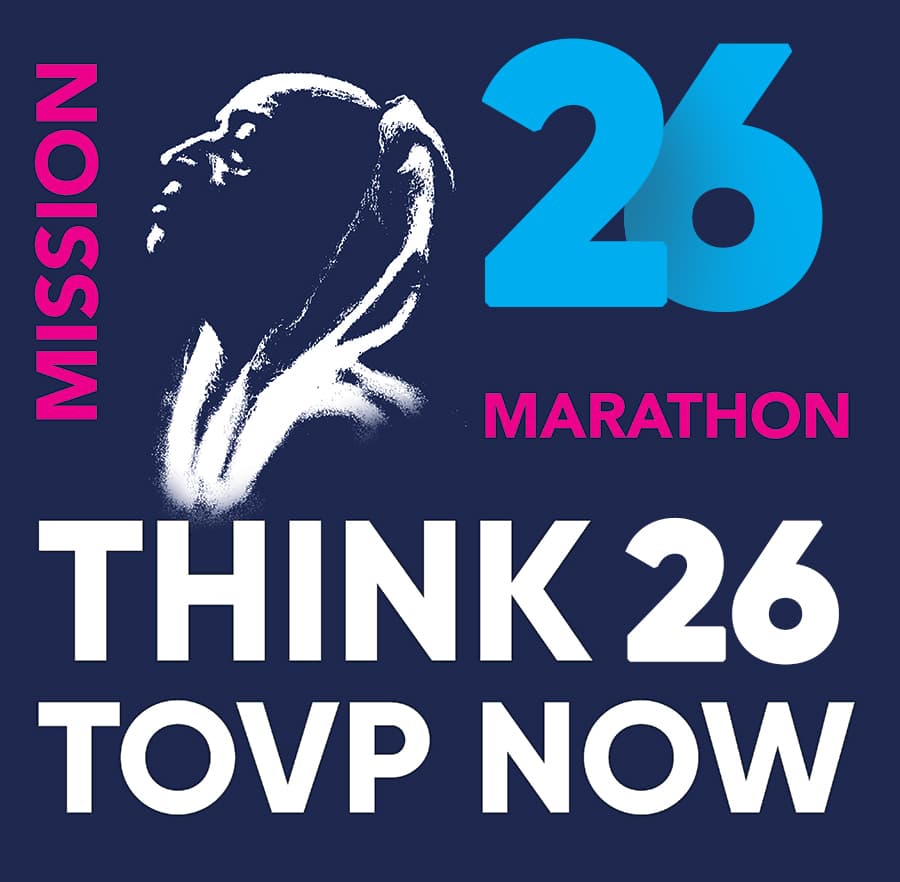The year 2022 is the 50th anniversary of the installation of Chota Radha Madhava in the Mayapur Chandrodaya Mandir by Srila Prabhupada himself. The TOVP is planning a huge, 4-day festival from March 2-5 to celebrate this event, as well as four other very important anniversaries this year, the Radha Madhava Golden Jubilee Festival.
The article below by Rishab prabhu is offered to inspire us in our remembrance of Sri Sri Radha Madhava as we approach the above auspicious festival.
In this spirit of remembering Krishna’s nature and appearance, and to increase your appreciation for Their Lordships Sri Sri Radha Madhava, we would like to present the many meanings of the name Madhava, which reflects both the sweetness of Lord Krishna in Vrindavana and the supreme opulence of Lord Vishnu. We will also describe the most prominent Radha Madhava deities that have been worshipped in our history.
The Many Meanings of Madhava
The name Madhava is a very prominent name for both Lord Vishnu and Lord Krishna. Srila Prabhupada has translated Madhava in his Bhagavad-gita and Srimad-bhagavatam in many ways: “Husband of the goddess of fortune,” “Master of all energies,” and “He who appears in the Madhu dynasty.” As a name of Vishnu, “Ma” refers to Laksmi and “Dhava” means husband or consort. In reference to Krsna, Madhava is usually explained as coming from the root “Madhu”.
“Srila Sanatana Gosvami has explained the various meanings of the word Madhava as follows: Madhava normally indicates Krsna to be “the Lord, who is the consort of the goddess of fortune, Laksmi.” This name also implies that Lord Krsna descended in the dynasty of Madhu. Since the spring season is also known as Madhava, it is understood that as soon as Lord Krsna entered the Vrndavana forest, it automatically exhibited all the opulences of spring, becoming filled with flowers, breezes and a celestial atmosphere. Another reason Lord Krishna is known as Madhava is that He enjoys His pastimes in madhu, the taste of conjugal love.”
(SB 10.15.2)
Jayadeva Goswami’s Radha Madhava
In our Vaishnava history, many important Radha Madhava deities have been worshipped by famous devotees. The oldest we know about belonged to Jayadeva Goswami, who lived in Navadvipa about 700 years before Lord Caitanya. Jayadeva is described by Srila Prabhupada as a pure devotee and a mahajana, and his Gita-govinda was relished by Lord Caitanya Himself.
One day as Jayadeva was worshipping Radha Madhava in Campahati, They appeared before him in a vision and transformed into Lord Gauranga, who is described in the Caitanya-caritamrta as being the same golden color as the campaka flower. Lord Gauranga told him to move to Puri. Many years later Jayadeva Goswami moved to Vrindavana and his deities are still there today in the Radha-Damodara Temple. Srila Prabhupada lived there for six years before coming to the west, and he was trying to organize the construction of a temple for them in 1965.
Bhaktivinoda Thakura’s Radha Madhava
Another important set of Radha Madhava deities are the family deities of Bhaktivinoda Thakur. They were originally worshipped in Bengal by Krsnananda Dutta, who was a disciple of Lord Nityananda and the father of Sri Narottama Das Thakur. When Krsnananda retired he moved to Puri, and then settled in the nearby village of Choti. The worship was passed down from generation to generation until it came to Bhaktivinoda Thakur and Bhaktisiddhanta Sarasvati Thakur.
Unfortunately, after Srila Bhaktisiddhanta’s disappearance the worship became neglected. In about 1950, a neighboring family wanted to claim the land which was in the name of the deities. They stole the deities and buried Them, telling everyone that the deities had become broken and thus had to be submerged in the river.
Although lost for many decades, They were re-discovered in the year 2000 and are now being worshipped in Kendrapara until their new temple can be built in Choti. Every Kartik They travel to Vrindavana to sit on the altar with Radha Syamasundara in the Krishna Balaram Mandir.
Jaya Radha Madhava – “This is original Krishna”
Bhaktivinoda Thakur published a collection of songs and prayers in 1893 called Gitavali, which included the bhajana we know as “Jaya Radha Madhava”. Srila Prabhupada had a very deep connection with this song, which he introduced after naming the Radha Madhava deities who are currently worshipped in Mayapur.
While Srila Prabhupada was traveling in India in 1971, he received three sets of Radha Krsna deities from a gentleman named Mr. Dalmia. Prabhupada sent one set to the ISKCON center in Boston (Radha Gopivallabha), one to the center in Berkeley (Radha Gokulananda), and one set (Radha Madhava) he kept with him. On the 11th of February, 1971, in Gorakhpur, Srila Prabhupada organized an installation ceremony for Sri Radha Madhava, and introduced the song ‘Jaya Radha-Madhava’ to the devotees. From this time forward, Srila Prabhupada began regularly singing Jaya Radha Madhava before his lectures.
Over the next three days he elaborated on its meaning. He explained that this song describes the “Original Krishna” in Vrindavana.
“This is actual picture of Krishna, Radha Madhava, giri vara dhari. Original Krishna this is. Radha Madhava giri vara dhari. Vraja jana vallabha. His business is to please the inhabitants of Vrndavana. That’s all. He has no other business. And the vraja jana also, they have no other business than to please Krishna. That’s all. This is original Krishna.”
(Purport to Jaya Radha-Madhava, February 14, 1971, Gorakhpur)
As Satsvarupa Maharaja recalled in his Prabhupada Lilamrta:
On the third morning after introducing Jaya Radha Madhava, Prabhupada again sang it with the devotees responding. Then he began to explain it further. Radha Madhava, he said, have Their eternal loving pastimes in the groves of Vrndavana. He stopped speaking. His closed eyes flooded with tears, and he began gently rocking his head. His body trembled. Several minutes passed, and everyone in the room remained completely silent. Finally, he returned to external consciousness and said, “Now, just chant Hare Krsna.” After this, the Radha Krishna Deities of Gorakhpur became known as Sri Sri Radha Madhava.
After Srila Prabhupada’s tour concluded, Radha Madhava were worshipped in Calcutta for a year. In 1972, Srila Prabhupada bought the deities to Mayapur for the first International Gaura Purnima festival, and told the devotees that They should stay in Mayapur.
Mayapur Radha Madhava with Ashtasakhis
Srila Prabhupada wanted big deities for the Mayapur temple: Madhava should be 5′ 10″ and black marble; Radharani should be 5′ 81/2″ and white marble. He said their pose should be like that of the small Deities. Although They did not appear during his lifetime, he nevertheless set their arrival in motion.
In 1978, Prabhupada came in a dream to a wealthy industrialist and ISKCON devotee named Radhapada Dasa. Srila Prabhupada asked him to help the Mayapur devotees, which inspired him to sponsor the carving of the large Radha Madhava deities. They were carved in Jaipur, and installed in Mayapur during the 1980 Gaura Purnima festival. Four of the gopis were installed in 1986, and four in 1992. So, the small Radha-Madhava deities have been in Mayapur for 50 years (in 2022), and the large deities for 42 years (in 2022).
Radha Madhava’s New Home
Krishna’s position as the most worshipable Person in the Universe was clearly established at the Rajasuya sacrifice. The Pandavas conquered the entire planet and collected tribute from everyone in order to accomplish this. Yudhisthira was not motivated by personal fame, ambition or ego. He simply desired that Krishna should be exalted and worshipped in front of all the important kings, sages and demigods of the universe.
As the Pandavas engaged the wealth of the planet in worshipping Krishna by honoring Him at the Rajasuya Yajna, we at the TOVP are trying to follow in their footsteps by raising funds from all directions to build a grand temple for Sri Sri Radha Madhava that will spread Their name and fame throughout the world.
TOVP NEWS AND UPDATES – STAY IN TOUCH
Visit: www.tovp.org
Support: https://tovp.org/donate/
Email: tovpinfo@gmail.com
Follow: www.facebook.com/tovp.mayapur
Watch: www.youtube.com/c/TOVPinfoTube
View at 360°: www.tovp360.org
Twitter: https://twitter.com/TOVP2022
Telegram: https://t.me/TOVP_GRAM
WhatsApp: https://m.tovp.org/whatsapp2
Instagram: https://s.tovp.org/tovpinstagram
App: https://s.tovp.org/app
News & Texts: https://s.tovp.org/newstexts
RSS News Feed: https://tovp.org/rss2/
Store: https://tovp.org/tovp-gift-store/


